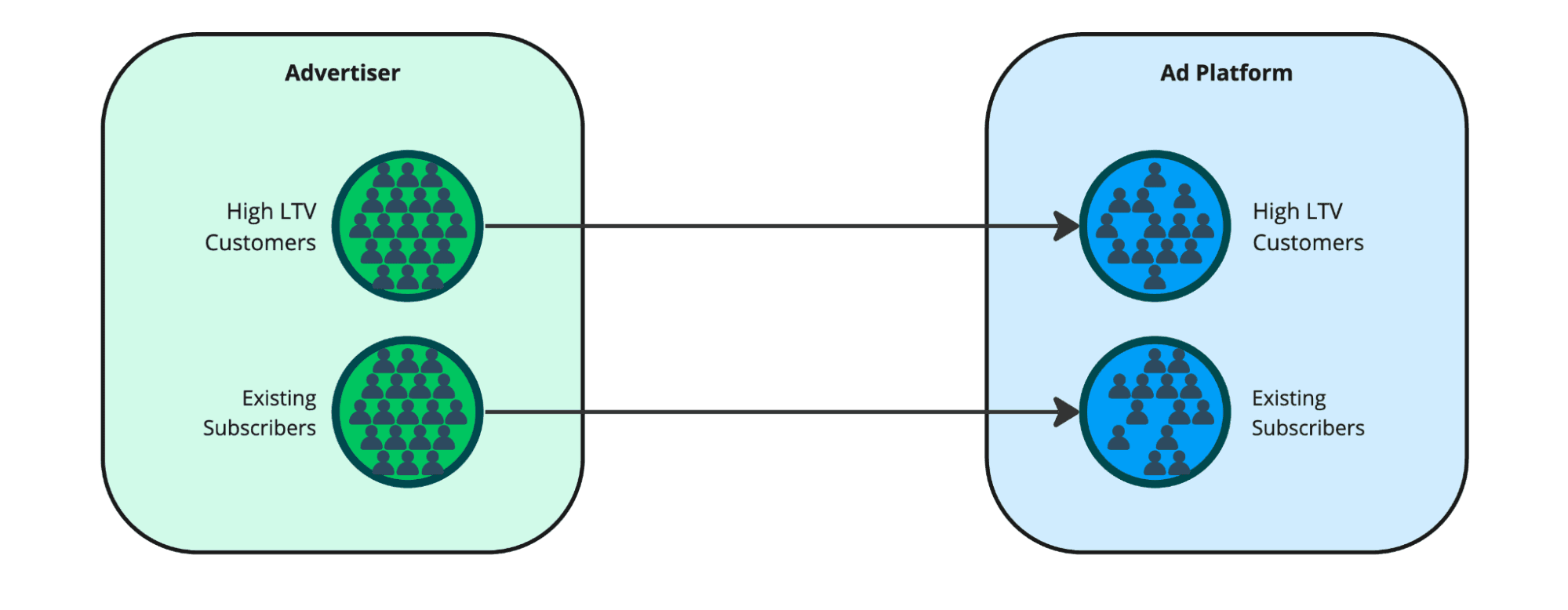This month marked one of the most significant changes to the advertising industry in decades: Google prompted 1% of Chrome users (30 million individuals) to cut off third-party tracking. The move is a clear signal that third-party cookie reliance is ending, and a new cookieless era of digital advertising is upon us. Google has taken a firm stance reinforcing this, committing that they would no longer delay and will transition to this privacy-first advertising approach by the end of 2024.
The timing for this change could not be worse for advertisers. Digital ad spending now surpasses $600 billion annually (yes, you read that right). It accounts for 70% of worldwide ad spend, and a recent study from Emarketer showed it’s projected to grow another +13.2% in 2024.
Performance marketers and advertisers everywhere now face a critical juncture: move quickly to learn about and adapt to new technologies centering on first-party data or risk significant declines in ad performance.
In this blog, we’ll share how brands are navigating this new privacy-first era. We’ll highlight how prioritizing first-party data strategies and technologies, like the data warehouse, sets today’s performance marketers up for success.
The Role of Customer Data in Advertising
Digital advertising is a data problem. It always has been, and it always will be.
Even in its early days, advertisers relied on data from ad platforms on basic metrics like spend, impressions, and clicks to understand overall campaign performance. Ad platforms, in return, relied on data signals from advertisers about customer engagement to enhance their targeting and optimization capabilities. This symbiotic relationship underpinned the entire AdTech ecosystem.

The bi-directional data flows with ad platforms
Advertisers have traditionally relied on third-party cookies and tracking pixels embedded in websites across the internet to gather behavioral data and target advertisements. Third-party cookies --cookies placed by a domain different from the one the user was visiting-- played a critical role in targeting advertisements across multiple websites. For example, a cookie from a car manufacturer could be placed on a device while a user shops for cars on their website. Future sites the user visits, like digital publishers, could then read these third-party cookies and use them to target on-site display ads with the exact car the user was looking at previously.
Alongside these cookies, third-party tracking pixels were also embedded into websites and emails. These invisible images send information back to ad platforms like Meta each time they are loaded, offering ad platforms near real-time data on user interactions like page views and product clicks. The combined data from these hundreds of thousands of websites equipped walled garden powerhouses like Meta with a rich trove of data that allowed them to build detailed user profiles and significantly enhance their targeting abilities.

The early days of adtech were powered by third-party cookies and pixels
A Changing Advertising Landscape
While the technologies mentioned above came together to build the foundation of advertising, increasing concerns about user privacy and regulatory changes have led to a significant shift in the industry away from these third-party cookies and browser-based solutions. This shift, often called 'cookie deprecation,' is driven by several key factors.
First, regulatory policies such as GDPR in Europe and various state-level privacy laws in the US have set new standards for consumer data privacy, emphasizing the need for explicit user consent for data collection and usage. This regulatory push reflects a growing global emphasis on protecting personal data and maintaining user privacy. Additionally, consumers are becoming increasingly aware of how their data is collected and used, leading to a demand for greater control and transparency. This has brought to light the shortcomings of third-party cookies as a reliable data source.
In response, browsers such as Safari and Firefox have already phased out privacy-intrusive third-party collection methods. However, their actions have not had a significant impact compared to what we will witness this year when Google Chrome, which is responsible for 65% of global browser usage, rolls out its cookie deprecation initiative.

With little ability to rely on browser-based trackers to silently collect and send user interactions for ad platforms to utilize, advertisers are now forced to rethink their strategies. Instead, the focus is shifting toward first-party data. This data, collected directly from users with their consent, is becoming the new gold in digital marketing. It offers brands and advertisers a more privacy-compliant way of understanding consumer preferences and behaviors.
Preparing for a Cookieless World
While many advertisers are just beginning to prepare themselves, advertising platforms have had years of notice and have been investing in powerful new technologies, features, and products to help overcome this signal loss. While many new technologies have emerged, like Google’s Privacy Sandbox and various Universal IDs, three of the most impactful strategies and technologies specific to performance marketers today are first-party audiences, Conversion APIs, and Data Clean Rooms.
First-Party Audiences
Audience targeting is an effective strategy to enhance campaign performance. Performance marketers use this strategy to retarget cart abandoners, suppress existing customers, and create lookalikes from their most valuable users.
To create first-party audiences, marketers collect customer behavioral data across their websites and mobile apps. They store this data centrally and use audience segmentation tools like Hightouch to define logic such as "users who browsed for X product but didn't purchase." After creating the audiences, they sync them to their desired ad platforms and customer engagement tools. When syncing these audiences, it’s essential to include as many customer identifiers (e.g., email address, first name, and IP address) as possible to ensure that the ad platforms can match their customers to their online profiles within the ad platform.

Audience match rates drastically impact your ability to target all users
Conversion APIs
As mentioned, advertising platforms have historically relied on client-side pixels to gather information on conversions such as page views and product clicks. However, the effectiveness of these pixels has substantially decreased over time with ad blockers and browser changes. That's why Conversion APIs (CAPIs) have become a popular alternative and are now an essential tool for any marketer looking to improve their ad performance. Using CAPIs, advertisers can easily send conversion events (behavioral data signals) directly to ad platforms from their back-end systems, allowing them to "close the attribution loop" without worrying about their events being blocked.
“The Conversions API is the foundation on which everything is built for performance on Meta […] If you have not set up the Conversion API, make this your number one priority.”

Meta
2023 Industry Report at in Partnership with Deloitte
Similar to pixel-based conversions, ad platforms use these signals to optimize campaigns, (e.g., shift more budget to users like those who purchased) and improve attribution, (e.g., of users who clicked an ad and then purchased). However, sending conversions to CAPIs ensures this data transfer is handled securely, efficiently, and with control. This addresses the privacy concerns related to cross-site tracking pixels while providing ad platforms with better signals. AI capabilities then leverage these enhanced signals for optimization, resulting in more effective ad campaigns and insights.

The server-side transfer of conversions to CAPIs
Data Clean Rooms
Data Clean Rooms have emerged as a secure and effective solution for multiple organizations to collaborate on customer data without compromising privacy. Clean Rooms enable brands to perform complex analyses like cross-site attribution, which previously relied on DMPs and now ineffective device IDs or third-party trackers. This allows brands and advertisers to process and analyze first-party customer data in a secure, shared environment without exposing individual customer details.

Data Clean Room basics
Hosted clean room technologies like AWS Clean Rooms enable two parties to securely share their data before deriving insights from the matched users. Ad platforms are also releasing their own clean room technologies like Amazon Marketing Cloud, where advertisers can upload their own first-party audiences and conversion events to drive campaign and user insights from the data within the ad platforms themselves. By matching their first-party data to the vast amount of data within walled gardens, advertisers unlock insights like the percentage of customers who searched for specific products or saw certain ads across Amazon properties. These insights can then drive new product development and targeting strategies.
The Emerging Role of the Data Warehouse in Advertising
With the need to collect and store more first-party customer data than ever before, enterprises across industries are turning to Cloud Data Warehouses like Snowflake, BigQuery, and Databricks. More than just a storage solution, these platforms offer scalability, security, and powerful computing capabilities, making them ideal for handling extensive first-party data repositories. From customer events and user identifiers to campaign performance and product inventory–all of the valuable data across a business, cloud providers like Snowflake continue to release powerful new features that make it easier than ever to ingest and centrally store data in a data warehouse.

Centralizing all data in the Data Warehouse
With organizations on the path to data centralization in their data warehouse, they are often already sitting on a gold mine of first-party data. Advertising and marketing teams can then simply turn to warehouse-native Data Activation platforms like Hightouch to activate this gold mine of first-party data OUT to the many tools and advertising platforms where it is needed. These purpose-built products like Hightouch make activation use cases like conversion events to Conversion APIs and audience syncs to Ad Platforms or Data Clean Rooms easier and more efficient than ever before.

Activating data directly from the warehouse
Leading advertising teams, including Warner Music Group, AXS, and Weight Watchers, trust this new Composable CDP architecture to power their first-party data use cases. It allows organizations to collect, store, and model their data centrally (in the data warehouse) while enabling marketers to activate their entire data repository out to the many tools where it’s needed.

Marketer-friendly tools like Hightouch Customer Studio make audience activation seamless
Closing Thoughts
We are at the cusp of some significant changes in the digital advertising world. To comply with user privacy requirements while still achieving maximum campaign performance, marketers must become proficient in first-party data and privacy-focused techniques. As mentioned in this post, first-party audiences, Conversion APIs, and Data Clean Rooms will be the fundamental building blocks of large-scale digital advertising in the cookieless era.
The best way to integrate with each of these is through the adoption of the Composable CDP, which offers modular, purpose-built capabilities such as Event Collection, Identity Resolution, Audience Building, and Data Onboarding.
If you're already transitioning to these new methods or are considering doing so, we invite you to meet with our team to learn about how Hightouch can accelerate your transition today.















